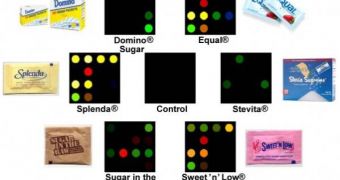Scientists at the University of Illinois have recently announced the creation of their new, artificial, tongue-like device, which is able to separate sweet tastes with remarkably more precision than our own tongues can. It can distinguish between many natural and artificial variations of sugar, including those used most commonly for drinks, chewing gums, cakes and cookies. The new device is no larger than an average business card, Wired informs.
“We take things that smell or taste and convert their chemical properties into a visual image. This is the first practical ‘electronic tongue’ sensor that you can simply dip into a sample and identify the source of sweetness based on its color,” UI chemist Kenneth Suslick, who has been part of the new research, says in a press release. The device works by analyzing pH differences that appear in a solution made from the sample and a derivative of the chemical boric acid, which the instrument contains.
In more than 80 trials, the artificial tongue was able to distinguish between 14 kinds of natural and artificial sweeteners with a 100-percent accuracy, which keeps all other similar devices ever created in check. In previous researches, the investigators managed to create electronic tongues sensible to taste, but they were not able to differentiate between similarly tasting compounds, and one of them even mistook the flavor of a human hand for the famous Italian bacon prosciutto.
“Actually, our sensor is much better at telling the difference between sweeteners than humans,” Suslick adds in an e-mail. Details of the new instrument were presented at the 238th annual meeting of the American Chemical Society (ACS) on Monday, in Washington DC.
“For routine quality control our device might be a substantial improvement, because one wants to compare to a known standard,” the expert adds. However, he mentions that there are some applications that will forever remain off-limits to robots. “For use in formulations (e.g., new recipes), there is no substitute for the human tongue, because after all, that’s what the consumer actually uses!” Suslick argues.

 14 DAY TRIAL //
14 DAY TRIAL //